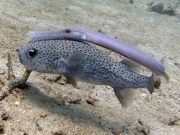Diving with Trumpetfish
Lanta Marine Life | Aulostomidae
There are three species of trumpetfish recorded world-wide, closely related to the pipefish, seahorses and cornetfishes. You'll often see this fish while diving Koh Lanta.
Trumpetfishes are generally slow-moving, active in the day-time, and often found singly around the reef, occasionally in pairs. This is a poorly studied fish, with little known about their behaviour.
Trumpetfish cleverly employ two distinct methods to catch their prey of small fish and crustaceans.
The first method is as an ambush predator, lying in wait close to hard corals or beside/within gorgonian fan corals to stalk prey or patiently wait for a target to appear. They often approach their prey in a vertical, head down position.
The second hunting method is to swim very close to another, larger fish, such as a grouper or pufferfish, or even a hawksbill turtle, allowing it to approach and attack its unsuspecting prey.
When darting in to catch prey, the extendable mouth can be rapidly expanded outward, and the mouth widened almost to the same diameter as the body. This process creates huge suction which rapidly draws the prey into the mouth.
The trumpetfish family name 'Aulostomus' is from the Greek: aulos, meaning flute, and stoma, meaning mouth, although this common name 'Flutemouth' is actually more often used to refer to Cornetfish (Fistulariidae).
1 species found on this page:
Chinese Trumpetfish
(Aulostomus chinensis)
The Chinese Trumpetfish has a long, thin, inflexible body, up to 80 cm in length, with a long tube-like snout, chin barbel, and very small teeth.
Chinese Trumpetfish exhibit three basic colour phases: uniform grey with a white spotted/black area toward the rear, grey and brown vertical stripes, or uniform yellow. The pelvic fins are located closer to the middle of the body and have a black spot at their base.
The rounded tail fin usually has two black spots, one on the top and sometimes a second spot on the low part. Even when grey/brown colour, the tail often retains a slight yellowish colour in parts. Individual fish have the ability to change their colours very quickly.

Aulostomus chinensis @ Koh Haa
As an ambush predator, the trumpetfish is the only known example of a fish that conceals itself by swimming closely behind or above another fish while hunting.
By choosing a non-threatening species as camouflage, such as pufferfish, they can sneak up on their prey without being detected.
As with many other species, reproduction involves the release of eggs and sperm into the water column, with pelagic larvae. Juveniles develop in the epipelagic zone, later moving to coral reefs.
Diving with Trumpetfish around Koh Lanta
Scuba Diving & Snorkel Trips
If you'd love a chance to spot Trumpetfish on one of our daily high season diving trips from Koh Lanta then send us an email to info@diveandrelax.com.
Join our high season speedboat dive trips to some of Thailand's best dive sites and enjoy small groups, short journey times, with a focus on great personal service, safety and fun.
Not yet a certified diver? Learn to Scuba Dive on Koh Lanta with the 3 day SSI Open Water Diver course.
Book online to save 10% on dive trips and scuba courses on Koh Lanta.
Find Out More
Indo-Pacific Marine Life Guides
- Allen, G., Steene, R., Humann, P., DeLoach, N. (2003) Reef Fish Identification, Tropical Pacific. Jacksonville, FL., USA: New World Publications, Inc., ISBN 1-878348-36-1.
- Humann, P., DeLoach, N., (2010) Reef Creature Identification, Tropical Pacific. Jacksonville, FL., USA: New World Publications Inc., ISBN 978-1-878348-44-9
- Debelius, H. (2013) Indian Ocean Reef Guide. Frankfurt, Germany: IKAN - Unterwasserarchiv, ISBN 978-3-939767-52-7.
- Debelius, H. (2004) Nudibranchs and Sea Snails, Indo-Pacific Field Guide. Frankfurt, Germany: IKAN - Unterwasserarchiv, ISBN 3-925919-51-1
- Erhardt, H., Knop, D. (2015) Corals Indo-Pacific Field Guide. Frankfurt, Germany: IKAN - Unterwasserarchiv, ISBN 3-925919-69-4.
- Veron J.E.N., Stafford-Smith M.G., Turak E. and DeVantier L.M. (2016). Corals of the World


